How to turn delivery tracking emails into a powerful, GDPR-compliant marketing channel?
Once the order has been paid, all the customer's attention is focused on tracking the delivery. He checks his emails to know the status of his package and to be reassured. Too often reduced to simple transactional messages, these emails can nevertheless become a powerful marketing tool: increase engagement, strengthen trust, generate additional sales... while remaining 100% compliant with the GDPR.
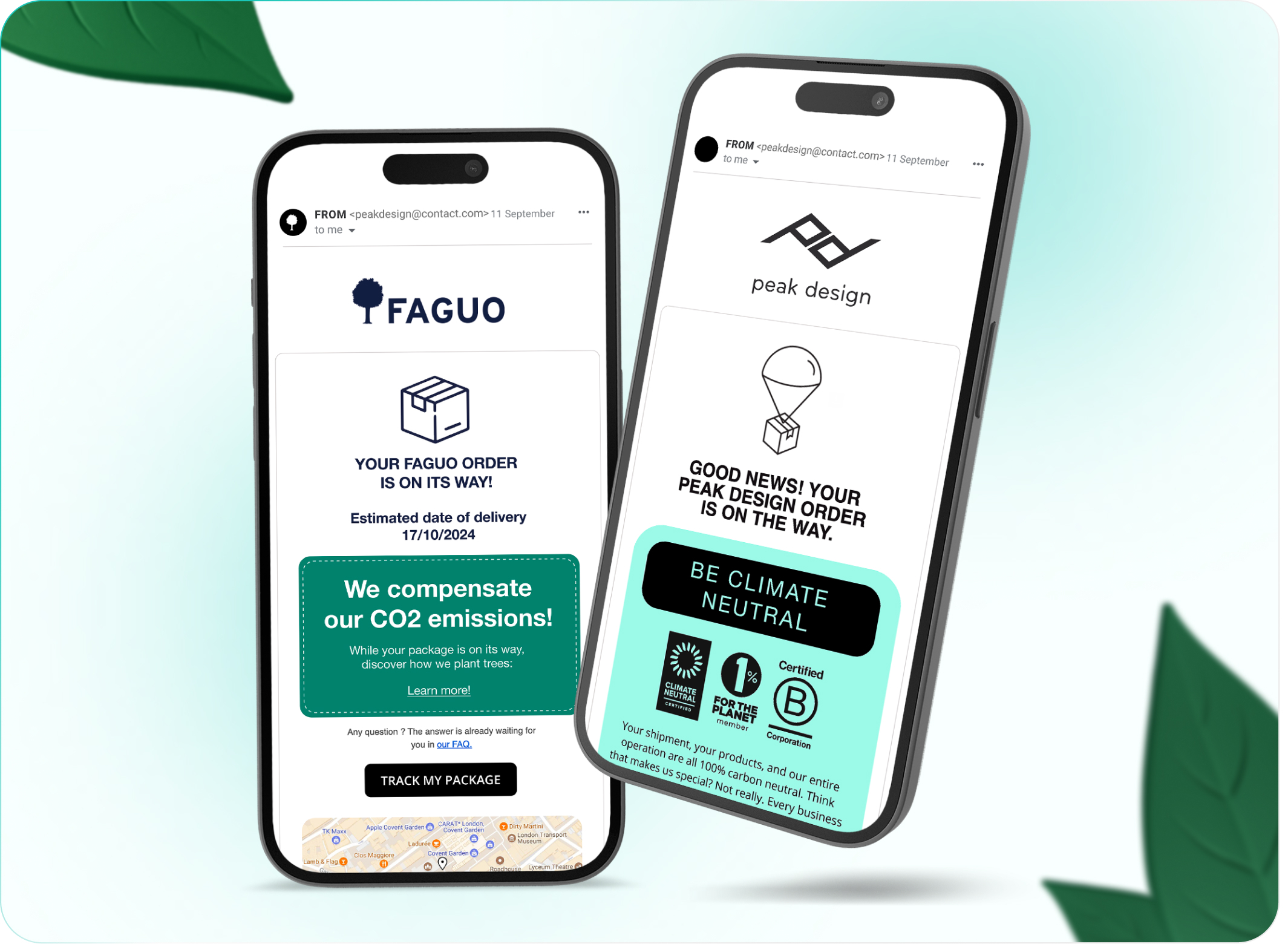
Post-purchase, a blind spot in the customer journey
For the customer, the buying journey does not end with payment. The transaction does not end until the package is received, or even when he decides to recommend (or not). However, most brands still focus a large part of their resources on the pre-sales phase: acquisition campaigns, tunnel optimization, retargeting, conversion optimization, etc.
While post-purchase, on the other hand, is often perceived as a simple logistical phase that brands put into the hands of carriers. Spoiler: it's a strategic mistake! Indeed, this phase of the customer experience represents up to 70% of the total interaction time between a brand and its customer after the order is placed, and above all, it is the time when customer attention is the strongest.
In fact, notifications related to delivery tracking (shipping confirmation, delivery tracking, incident notification, etc.) show average opening rates greater than 70% (average drawn from more than 150 million emails sent in 2025 with Shipup), more than double that of a traditional email marketing. We even reach 77% for the email that notifies the shipment of the order (average calculated on 35 million emails sent via Shipup). It is therefore a channel with a very strong affinity, capable of generating as much trust as revenue, provided it is properly exploited.
However, in most cases:
- the message comes from the carrier, not from the brand;
- the tone and design do not reflect the identity of the e-merchant;
- and no marketing content is integrated into it.
The result: frustrated customers, missed conversion opportunities, and customer support saturated with tickets. Shipup internal data (via customer use cases) shows that a merchant who takes back control of their post-purchase communications can reduce your “where is my package?” tickets by up to 40% and considerably improve its NPS: 82 NPS points for Nude Project after Shipup was set up. An NPS over 30 points above the average in e-commerce.
Post-purchase email: from transactional message to engagement channel
Post-purchase emails are no longer just shipping receipts. They have become a marketing channel in their own right, with unique engagement potential across all channels.
A channel with very high attention
Unlike promotional emails, the post-purchase email linked to delivery tracking benefits from a unique status: it is expected. The consumer actively monitors his order status: he opens, clicks, reads carefully. At Shipup, post-purchase notifications record on average:
- 70% opening* ;
- 25% clicks* ;
- and more than 20 seconds of average reading time, which is comparable to that of a personalized WhatsApp or SMS message.
It's a moment of attention that can reassure the customer, create a consistent brand experience, and in some cases even trigger new sales.
*Average calculated on 150 million emails sent in 2025 by Shipup.
A marketing lever under control
Where carriers send impersonal messages, Shipup allows brands to regain control of their post-purchase communication. With the integrated template editor and the “Marketing Campaign” feature, marketing teams can:
- create models adapted to each stage (preparation, shipping, delivery, incident, etc.);
- personalize the design and the texts without technical dependence;
- program and automate promotional banners in their emails;
- test and preview their messages in real time, in multiple languages and formats
Customers thus receive clear and consistent messages that reflect the brand. A simple “Your order is coming tomorrow” email becomes a natural extension of the shopping experience, which reassures and builds trust.
Thanks to the “Marketing Campaign” feature, this consistency is maintained over time: content is updated automatically according to planned campaigns, without manual intervention. Teams gain in agility during key periods (sales, holidays, launches...), while maintaining control over their image.
Premium brands find a double advantage in this: a smooth and consistent customer experience and a significant gain of time in managing their post-purchase communications.
The challenges ahead: consistency, automation, and compliance
Remain GDPR compliant
One of the most frequent obstacles to the marketing valuation of post-purchase emails is the fear of going outside the legal framework. The GDPR strictly regulates the use of personal data and prohibits unsolicited commercial communications.
However, post-purchase emails have a particular status: they are considered to be transactional. This means that they can contain all the information necessary for the correct execution of the order (shipping, tracking, delivery, satisfaction) without the customer's prior consent.
On the other hand, as soon as a message includes a promotional component (cross-sell, loyalty program, repurchase coupon, etc.), it becomes essential to maintain a certain balance: the main content must remain informative and focused on delivery, while the marketing part must remain in the background.
This balance between transparency and valuation allows brands to transform their post-purchase emails into powerful engagement levers without compromising the trust of their customers.
Omnichannel consistency
But the customer experience doesn't end with an email. The consumer expects to receive the same information, in the same tone, on all channels: email, SMS, Whatsapp, Apple Wallet... The challenge for brands is to maintain a coherent message and design through this omnichannel approach.
Shipup meets this need through its multi-channel notifications : messages sent by email, SMS or WhatsApp are synchronized, guaranteeing the same clarity and the same visual identity, regardless of the channel. Thus, a customer who consults their notification on WhatsApp finds exactly the same promise as in their email.
Automate without losing control
During periods of high activity (Black Friday, Christmas, sales), manually updating each template to insert a promotion quickly becomes unmanageable. Marketing teams are wasting time and increasing the risk of errors (untranslated banners, expired promotions, etc.). To overcome this, Shipup has developed a unique feature: marketing campaign programming. An intelligent automation system that allows you to schedule the display of marketing content directly in post-purchase emails.
With this feature, brands can:
- create dedicated locations in their post-purchase emails;
- program promotional or informational banners;
- Define start and end dates, with a specific time;
- manage multiple languages and visuals;
- add a default marketing campaign to avoid empty space
In practice, this means that a shipping confirmation email can automatically display a “Free delivery this weekend” banner and then return as early as Monday to a more brand-oriented message without human intervention.
For brands that use this feature via Shipup, there are 4 categories of marketing campaigns that offer an ultra-efficient click rate:
- the promotion of their mobile application, for brands that have one;
- the loyalty program;
- the new collections;
- elements that highlight the brand (e.g. B Corp certification).
ℹ️ This data comes from 1.8 million notifications sent by brands using the marketing campaign scheduling feature via Shipup.
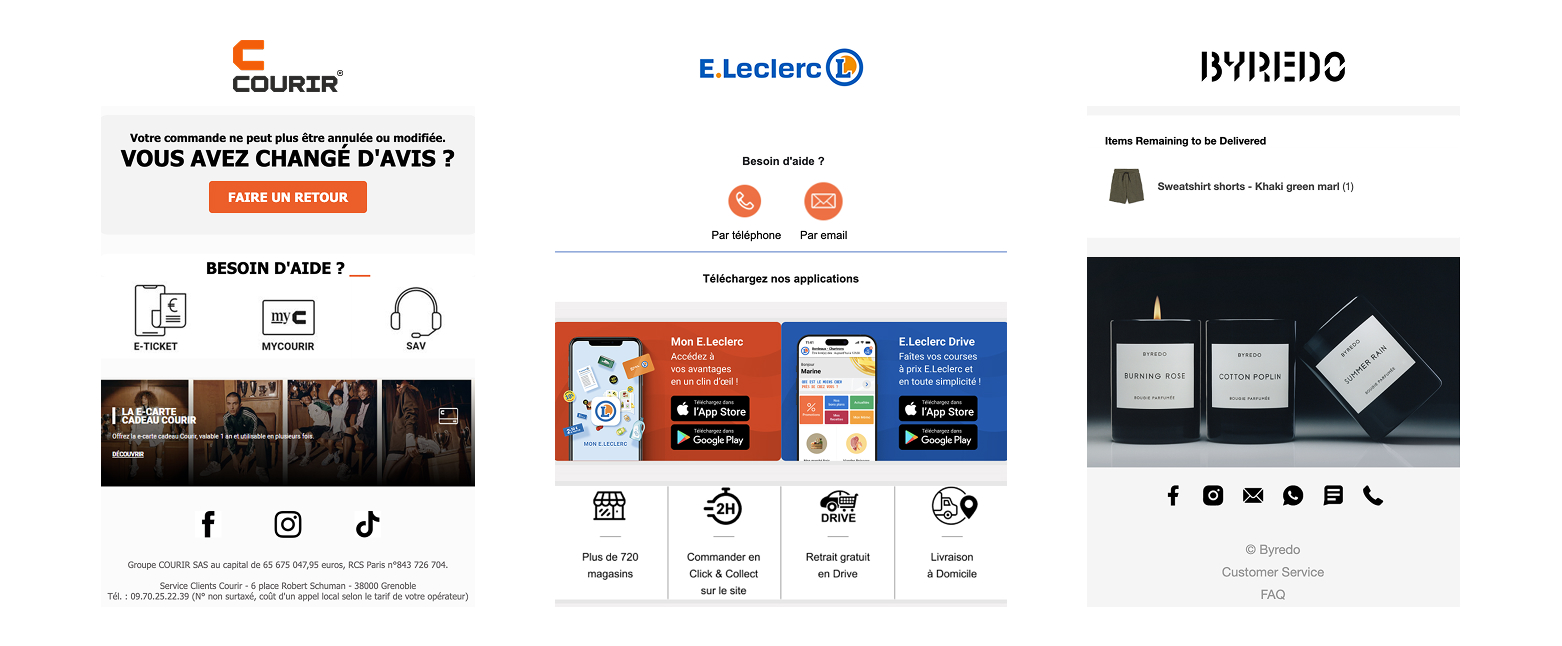
How Shipup turns post-purchase emails into marketing tools
1. Regaining control over the brand and the message
For many brands, post-purchase communication is the last uncontrolled area in their customer experience. The Shipup email editor is changing this situation. The templates are customizable: visuals, texts, fonts, CTA, dynamic modules. Teams can also preview the output by language, scenario, and device type.
This is what allowed Ultra Premium Direct to restore the coherence of its customer journey, by harmonizing post-purchase emails with its e-commerce charter. Result: +12% average click rate on notifications and a significant drop in the volume of support requests.
2. Automate integrated marketing campaigns
Thanks to the marketing campaign feature, post-purchase becomes a living marketing tool. CRM teams can orchestrate their campaigns as real highlights:
- In transit → “Your package is coming! Discover our new features.”
- Delivered → “Your opinion counts! Share your experience.”
- Incident → “Sorry for the wait, take advantage of a discount voucher.”
Each stage of the journey becomes a contextual point of contact. And thanks to the integrated planning system, there is no need to manually manipulate the banners: everything is updated automatically, with complete traceability.
3. Measuring performance and adjusting
The marketing impact of Shipup notifications is now measurable and traceable in your own analysis tools. Thanks to the Shipup dashboard and the “UTM Tracking” feature, e-retailers can:
- track open and click rates by channel;
- identify orders generated directly from a notification;
- measure the traffic referred to the site from the tracking page or promotional banners;
- compare the performance of each channel (email, SMS, WhatsApp, tracking page).
UTMs are automatically applied to all Shipup links (emails, banners, tracking pages). The results then appear in your usual tools (Google Analytics, Mixpanel, Amplitude, etc.) without additional settings.
This visibility makes it possible to prove the ROI of post-purchase communications, to identify the most effective levers and to adjust your campaigns in real time, directly from your analytics environment.
Customer cases: from support to marketing performance
Withings: from reactive to proactive
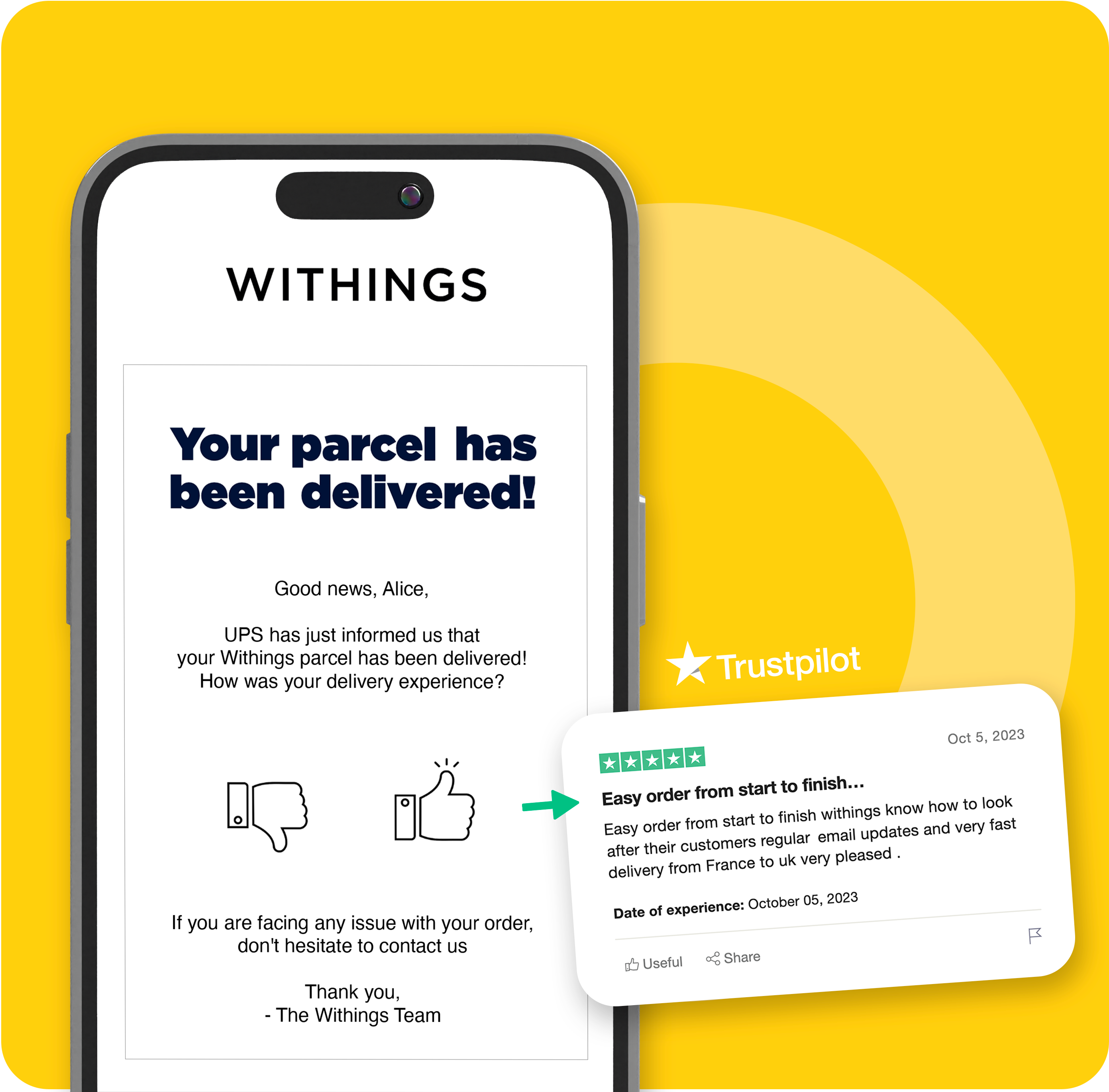
With a large volume of international shipments, Withings was facing an explosion of “Where is my package?” tickets. The team chose Shipup for Automate your notifications and standardize its customer discourse.
Result: -€80,000 in support costs per year, an opening rate greater than 80%, and a net improvement in the NPS.
Running: the brand's DNA, even in parcel tracking
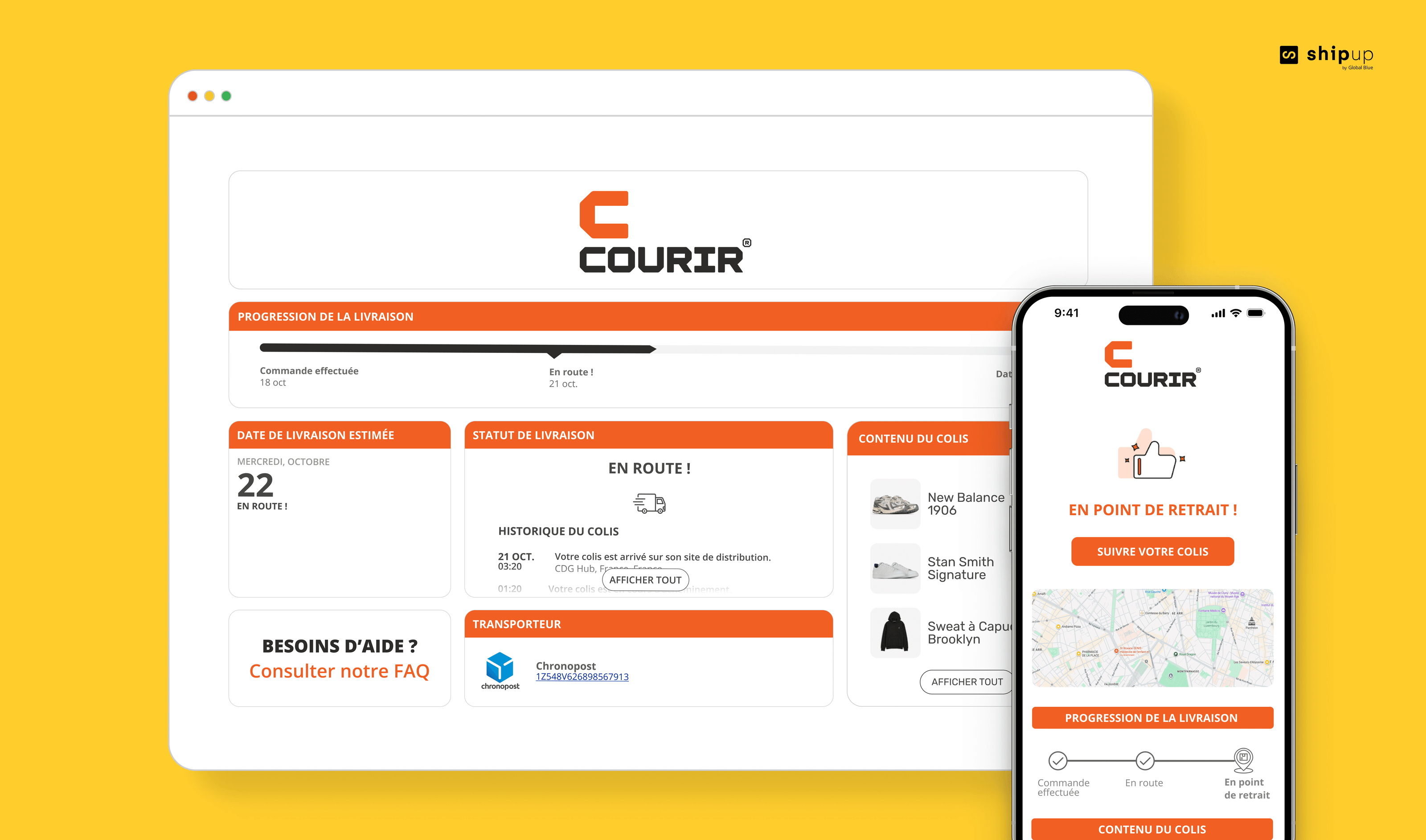
With a strong identity, Courier wanted to extend the brand experience beyond the purchase. By relying on Shipup, the brand has transformed each notification and each delivery step into a branded, consistent and engaging point of contact: from the site to the tracking page, to the multi-channel tracking notifications.
Result: +4 visits per order on the personalized tracking page, better customer activation throughout the post-purchase journey, and a premium experience that reinforces brand attractiveness.
La Bécanerie: a post-purchase experience as smooth as their customer service
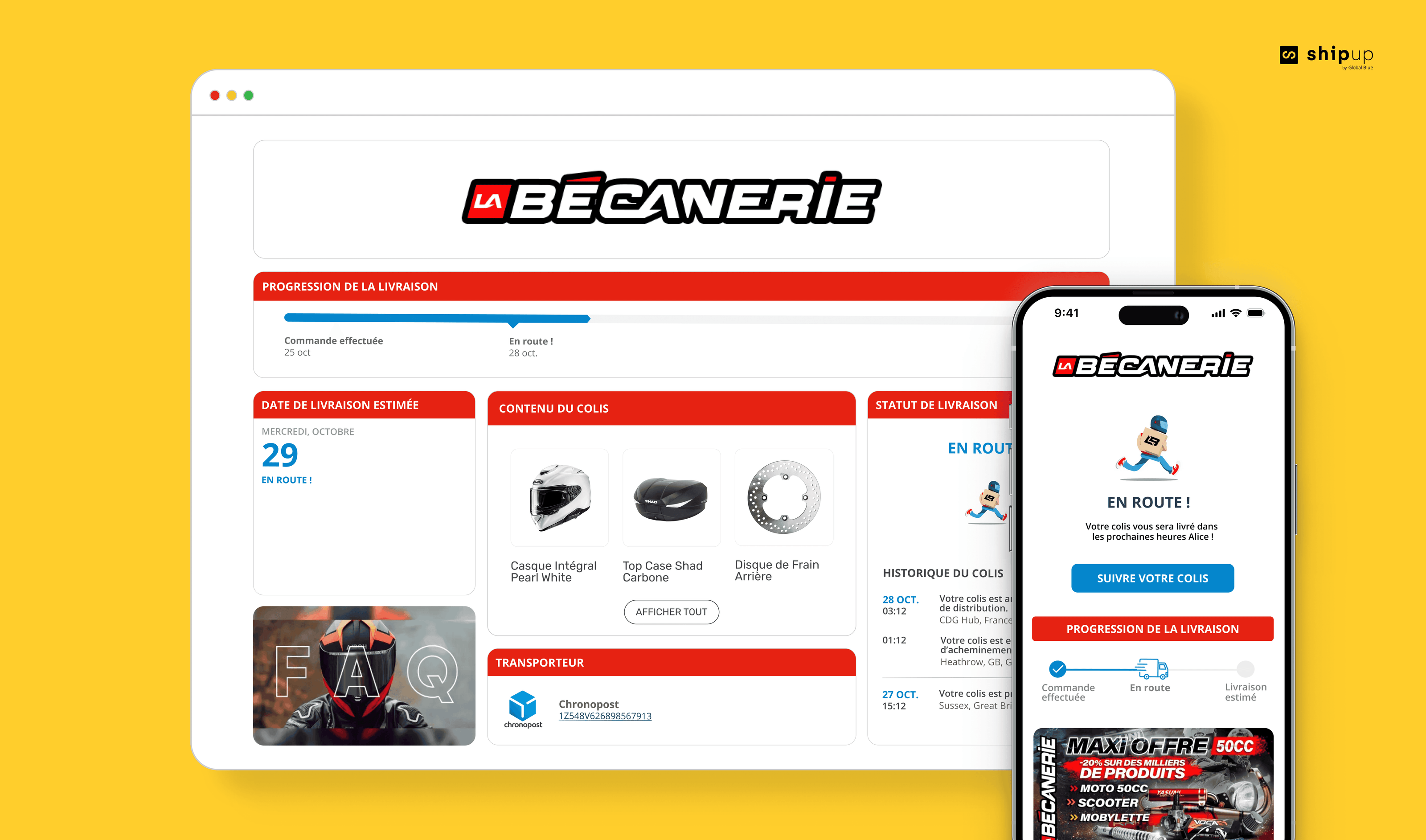
With a demanding and passionate community, La Bécanerie wanted to offer order tracking that matched its expertise and customer promise. Thanks to Shipup, the team has unified the entire post-purchase journey : an immersive tracking page, proactive notifications and reliable information at each stage to reassure, engage and value each shipment.
The result: a clear and consistent delivery journey, a significant reduction in follow-up requests, and a differentiating customer experience that reinforces the trust and loyalty of their community.
Best practices for an efficient and compliant post-purchase email
1. Pay attention to the structure of the message
Logistical information remains a priority. It should appear clearly: status of the package, tracking link, delivery estimate. The marketing part should never take over to remain compliant with the requirements of the GDPR.
2. Focus on personalization
Each notification can include dynamic variables: first name, product ordered, language, country, delivery date, type of carrier. A contextual approach reinforces relevance and proximity.
3. Integrate contextualized banners
Marketing inserts must adapt to the moment of the journey: a welcome message after the first order, an incentive for feedback after delivery, an offer targeted to the category of purchase.
4. Ensuring brand consistency
A post-purchase email should extend the visual universe of the e-commerce site. Font, colors, tone: everything should evoke the brand. Shipup templates facilitate this consistency across all scenarios and channels.
5. Measure, test, iterate
No campaign should remain static. The most successful brands test their templates, adjust the position of the banners, compare their click rates and optimize their content every quarter.
Towards a new era of post-purchase: from logistics to customer relationships
Post-purchase email is now a pillar of the customer experience. It is no longer a question of simply informing, but of communicating with meaning: reassuring, thanking, re-engaging. Brands that adopt this vision turn delivery into a moment of positive emotion and follow-up into a proof of consideration.
The future of e-commerce no longer depends only on the conversion tunnel, but in the quality of post-purchase follow-up. Market leading brands have understood this: mastering the delivery phase means extending the brand promise to the end of the customer experience.
Because basically, a good post-purchase email is not the one that informs you that a package is coming. It is the one that reminds the customer why they were right to choose this brand.




.png)





